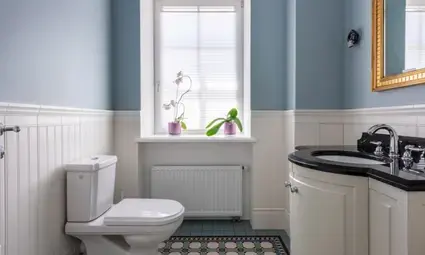
Shopping for a toilet can be an exciting venture. With the steady stream of new innovations, you have dozens of options and styles to consider. And while the sheer number of choices can seem overwhelming, it need not be so if you look closely at the unique features of each one.
After all, many of the toilets look much the same. Whether you buy a toilet for £100 or £1000, both will do the job. But remember, you’ll only get the features that you pay for.
The major factors to consider before you go looking for the best toilet for your bathroom include:
- Bathroom Style (modern or traditional)
- Budget
- Toilet Style, Shape, and Height of The Toilet (related to bathroom space)
- Toilet Mechanism
- Toilet Technologies
A minimalist toilet will complement a modern bathroom, while a more elaborate toilet will suit a traditional bathroom.
In this expert guide, we’ll take you through the different options and factors to consider before you make the investment.
- Toilet Style, Shape, and Height
- Style
- Shape
- Height
- Toilet Mechanism
- Toilet Technologies
- Some Final Thoughts on Choosing a Toilet
Navigate to any section of this post by clicking on the links above.
Toilet Style, Shape, and Height
Style, shape, height, as well as, size and functionality are all key points to consider when choosing a toilet for your bathroom. You’ll also need to keep in mind the people who are going to use the toilet on a regular basis.
Therefore, before you head out to buy a new toilet, one of the first things to do is to measure your bathroom space, specifically where the toilet is going to go. The most important measurement to take is the rough-in – the distance between the wall and the floor drain. This is usually around 12 inches, perhaps 10 or 14 inches for older homes.
Most toilets come in one of three style variations: two-piece, one-piece (close-coupled), or wall-mounted. The first is the most common: this is where the tank and bowl are separate, and it’s what you’ll find in most traditional bathrooms.
Bathroom City offers all three variations.
Style
a. Close-Coupled Toilets
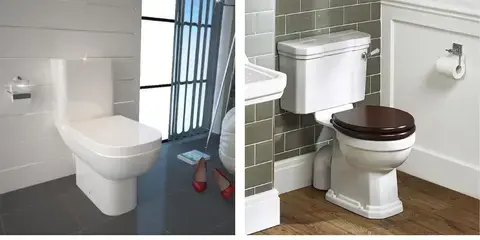
With one-piece toilets, also known as close-coupled toilets, the cistern (water tank) and bowl are fused together, which offers a sleeker, more stylish look for contemporary homes. The water tank is located directly behind the bowl.
b. Back-to-Wall Toilets
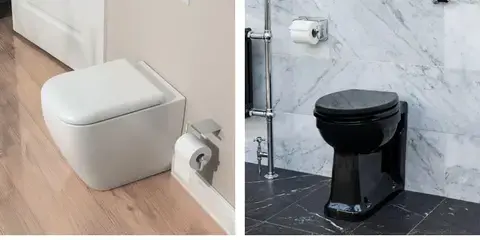
In back-to-wall toilets, the standalone toilet bowl is backed up against a wall. The cistern is concealed in the wall, while the floor-standing toilet bowl is fixed to the wall. This space-saver toilet suits a small bathroom to perfection.
c. Wall-Hung Toilets
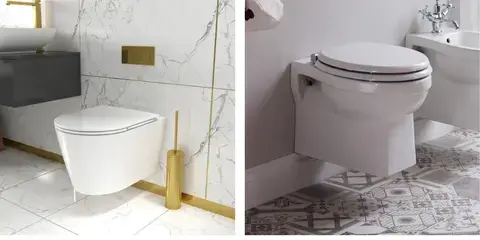
Wall-hung toilets, as the name suggests, hang from the bathroom wall. Unlike back-to-wall toilets, they have no foot or base, which makes them easier to clean underneath – and a better choice for people with walkers or wheelchairs.
Shape
Next, consider what bowl shape you’d prefer.
a. Elongated Bowl
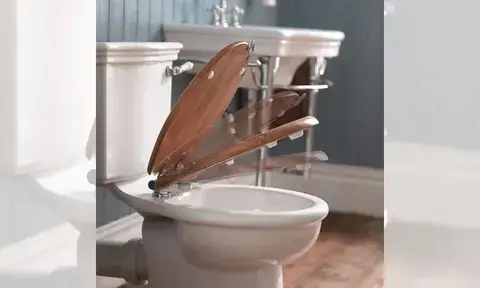
Elongated bowls are popular because they’re more comfortable to sit on. The larger surface area of this bowl makes it easy to use with less mess.
Since the front part of the elongated bowl juts out forwards more than it does in the other types of bowls, it’s more suitable for family bathrooms.
b. Round Bowls
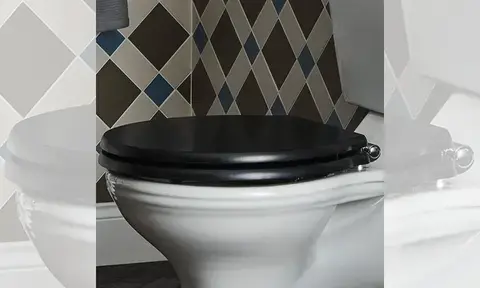
Round bowls take up less room compared to the other types of bowls and are usually cheaper. The main advantage of this space-saving bowl is that it fits comfortably in a small bathroom.
A round bowl is the right fit for small children. But this could prove to be a temporary benefit.
c. Rectangular Bowls
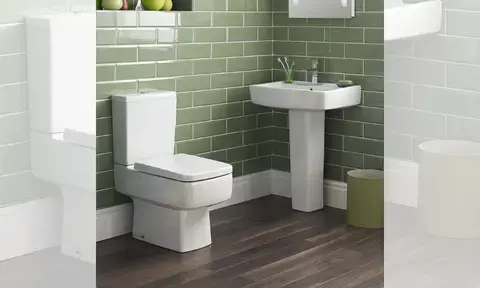
Rectangular bowls are a modern variation.
The sharp, clean lines of a rectangular bowl draw the eye in a unique way. It’s a strong choice for a family bathroom because it delivers a superior user experience.
Height
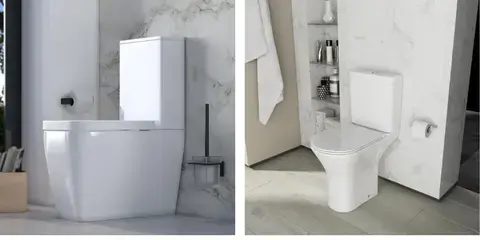
Once you have chosen the style and shape of the toilet, height is the next consideration.
a. Standard Height
The right toilet height is important because it affects the user’s level of comfort.
That said, the height of a standard toilet is between 15 and 16 inches from the bathroom floor to the top of the toilet seat. This height is slightly lower than the standard chair height, which is 18 inches. So, the standard toilet height is too low for tall people.
The standard toilet height has remained almost unchanged since the flush toilet became popular more than 150 years ago. However, in the meantime, the average height of men in the UK has gone up by more than 4 inches.
b. Comfort Height
The height of a comfort toilet varies from 15.75 inches to 18.1 inches.
Comfort height toilets cater better to the needs of tall people, the elderly populace, and people with mobility issues.
You can also find elevated toilets that are approximately 2–4 inches taller for those who struggle to get up and sit down.
Toilet Mechanism
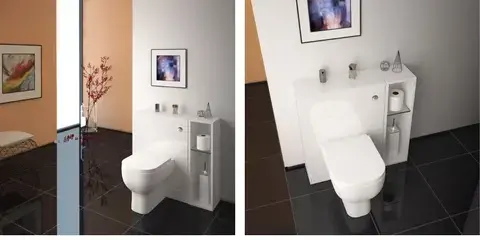
The flush valve, the main toilet mechanism, rushes water from the cistern (water tank) into the bowl to clear away waste.
a. Gravity Feed vs. Pressure-Assisted
Depending on the flush type, most toilets fall into two basic categories: gravity feed and pressure-assisted.
As the name implies, gravity feed toilets have a flush valve that relies on – you guessed it – gravity. Water falls from the tank into the bowl, moving waste down the drain.
The main benefit of the gravity feed mechanism is that the flushing action is quieter than in a pressure-assisted toilet. But if you want one that performs to the same level as in a pressure-assisted toilet, you’ll almost certainly end up paying more.
Gravity-feed toilets are still the most commonplace, but pressure-assisted is worth considering, especially if you have a large family. So, you may be wondering, “What is the difference?”
In a pressure-assisted model, water compresses the air within the sealed tank, creating pressure that forces the waist down. A pressure-assisted toilet is a wise option for a household with many people, but the downside is the flush is much noisier.
b. Water-Saving Toilets
According to Water Wise, the top UK water efficiency NGO, the water used to flush toilets in UK homes comes to about 30% of total water consumption.
Even if it’s not the most glamorous, it’s fair to say that the toilet is one of the most important items in your home. It can certainly help you save a lot of water. Hence, you need to choose the right one.
Water is a precious resource. The primary advantage of water conservation is it can save the environment and provide resilient habitats for birds and other wildlife. So you simply cannot ignore the long-term benefits of saving water.
Aesthetic considerations like colour and style are important, but just as important is how well your toilet functions and how much water it uses. A good toilet should generate enough power to effectively clear the bowl with one flush while also conserving water as much as possible.
In the average household, the number of flushes per day is 5. The cistern in a modern water-saving toilet uses 5 litres/flush. But the water consumption per flush in an older toilet is 9 litres.
That would translate to a water saving of 4 x 5 = 20 litres/day or 7,300 litres/year in your household.
The initial round of ‘low flush’ toilets to come onto the market in the 1990s wasn’t all that water efficient. Yes, they used less water per flush, but people had to flush several times to get enough power out of them, which sort of missed the point.
Now, the latest water-saving toilets are much more powerful, with a range of design improvements that enable them to create a stronger rush of water while using less of it. What’s more, you can opt for a dual flush cistern – a 0.8-gpf button for liquids and a 1.6-gpf button for solids – which means you can get that extra power if needed.
Look for water-saving toilets with good online ratings, and if efficiency is a priority for you (as it really should be for all of us), consider getting a pressure-assist model.
Toilet Technologies
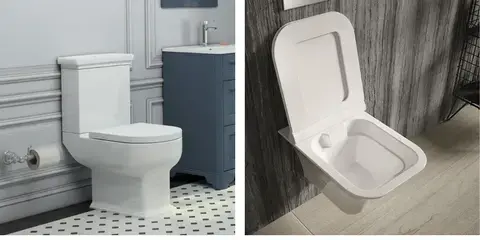
Who says innovation doesn’t apply to the toilet? As with everything else, there are always people at work to make the modern toilet perform better, last longer, and work harder.
a. Soft Close Seat Toilets
More and more, we’re seeing a trend in toilets with slow-moving or soft close hinges, which lower the seat and lid gradually rather than slamming shut. Soft close seat toilets are designed for style and comfort.
In addition, self-cleaning toilets are entering the fray, removing the need for one of your home’s least appealing domestic chores. And, if you want a really fancy toilet, you can opt for one with a high-tech antimicrobial glaze that gives it a super smooth finish while simultaneously inhibiting bacteria growth.
b. Rimless Toilets
Unlike a traditional toilet, a rimless toilet does not have a classic rim on the side. The rimless design simplifies cleaning.
The beautiful aesthetic of rimless toilets simply sets them apart. They are also highly functional as they improve hygiene and save water.
Rimless toilets are available in an assortment of styles and designs – wall hung, standard height, comfort height, close-coupled, back-to-wall, and more.
Some Final Thoughts on Choosing a Toilet
Generally speaking, when it comes to buying the best toilet for your bathroom, boring is better. If you opt for something trendy, quirky, or unusual, you may start to wish you hadn’t further down the line.
For example, say you opt for something ultra-cool and custom. But years later, when you come to replace those parts, you’re going to need to spend much more than if you’d opted for something mainstream.
Likewise, a bright pink toilet might seem like a fun option now, but when you try to sell your house some years later, potential buyers may well find it off-putting.
Finally, avoid cushioned seats altogether. They tend to be fraught with problems, as they break easily and do not age well. Wood and plastic toilet seats are a safer bet.
To shop for Toilets for your new or old bathroom, browse our full range of toilets. For more helpful tips on Choosing the Best Toilet for your Bathroom, read our helpful Toilets Buying Guide.
Other related articles that you might also be interested to read: